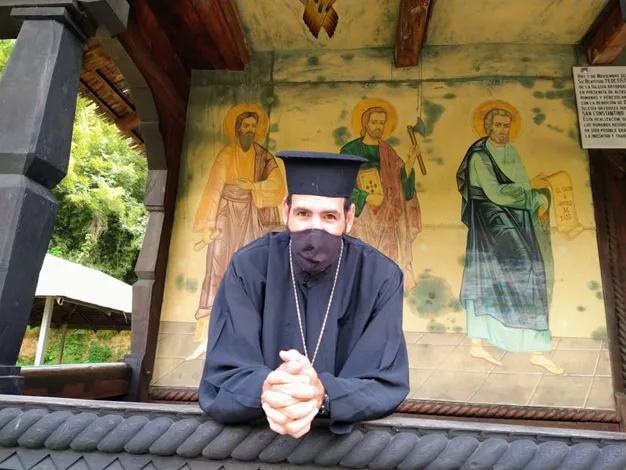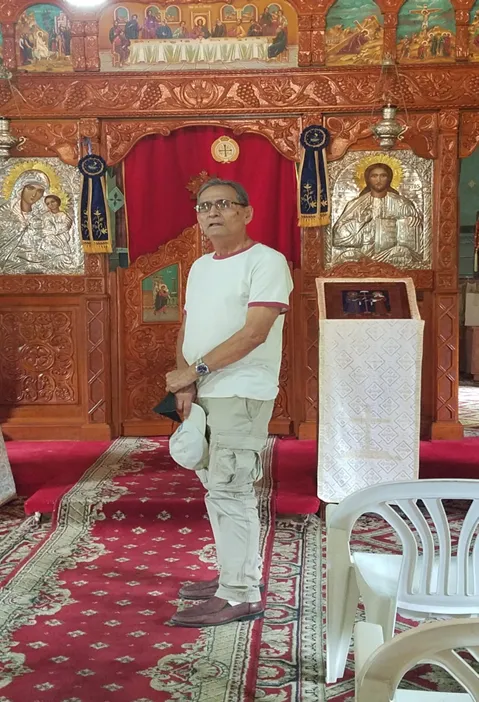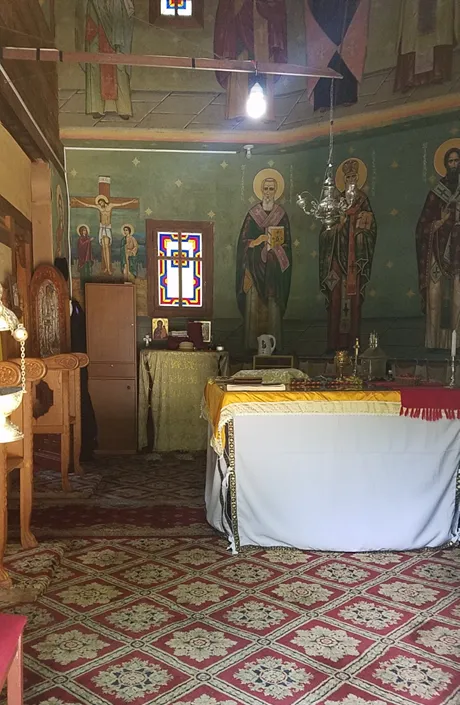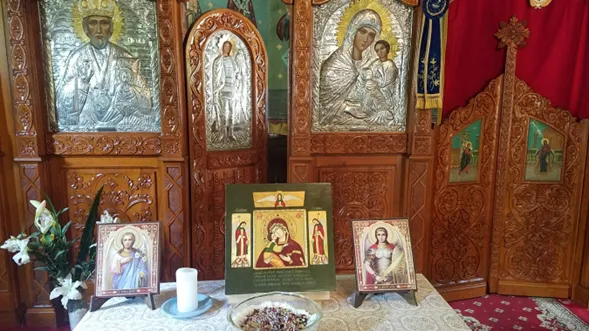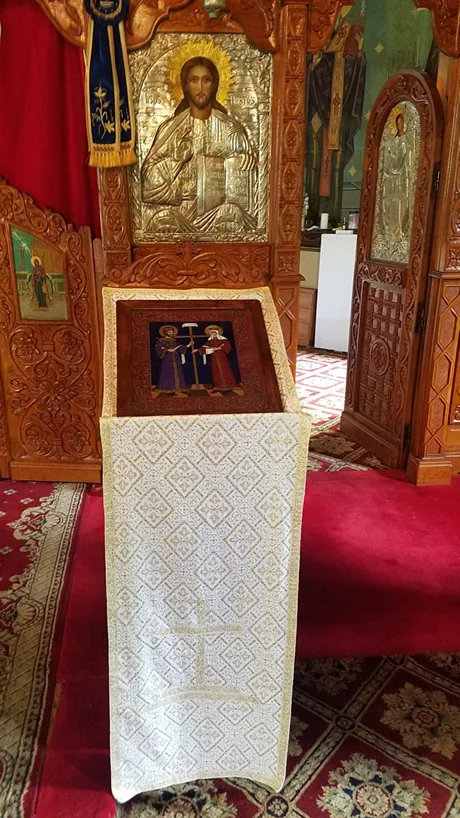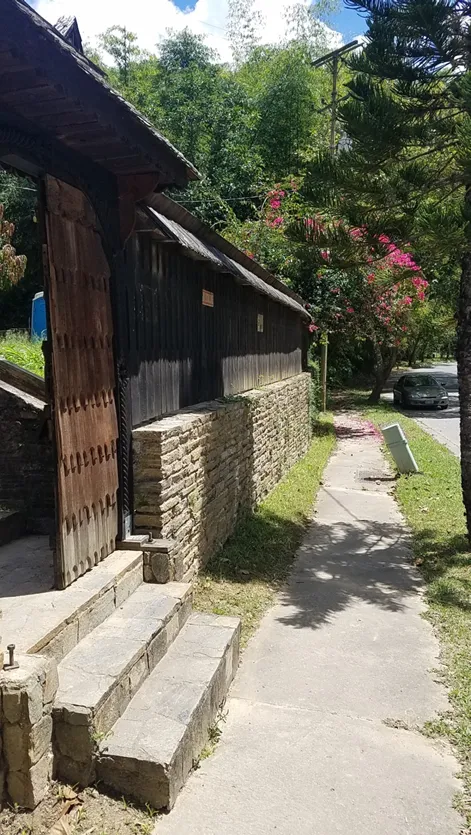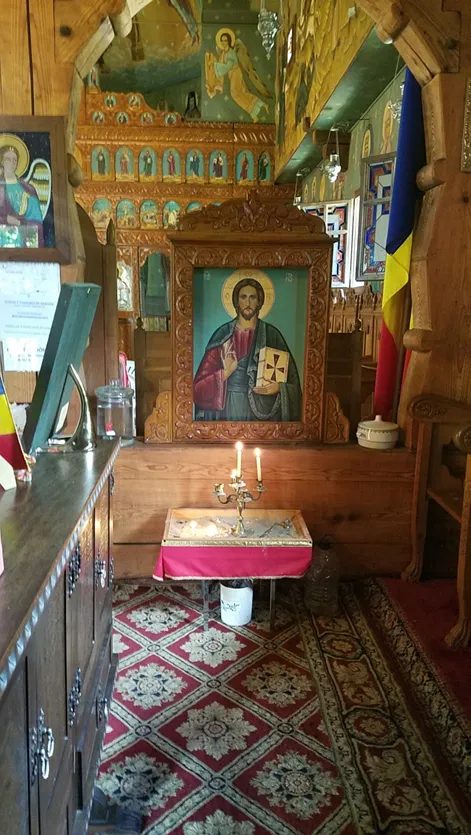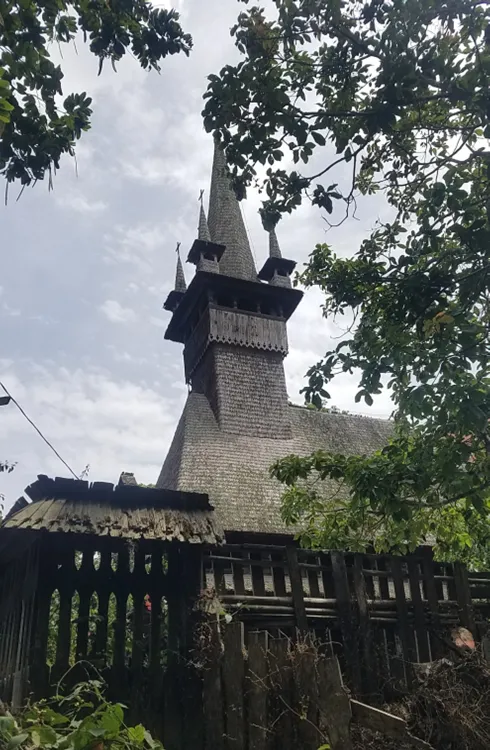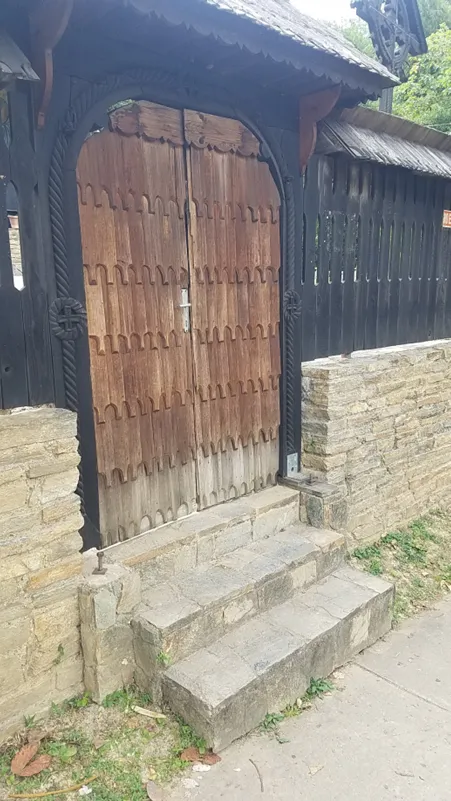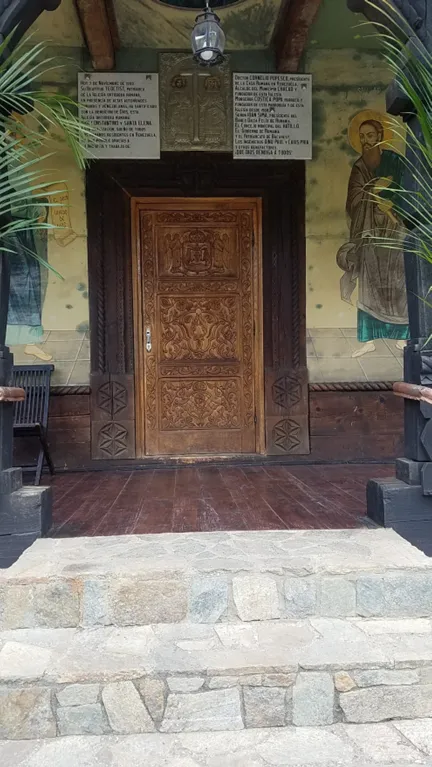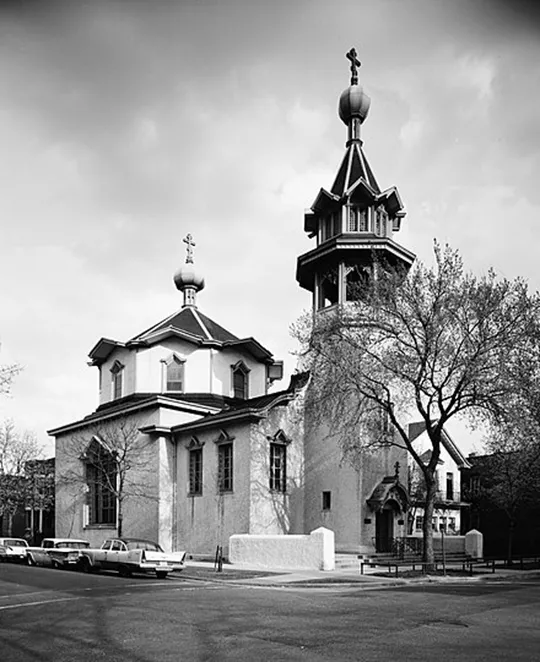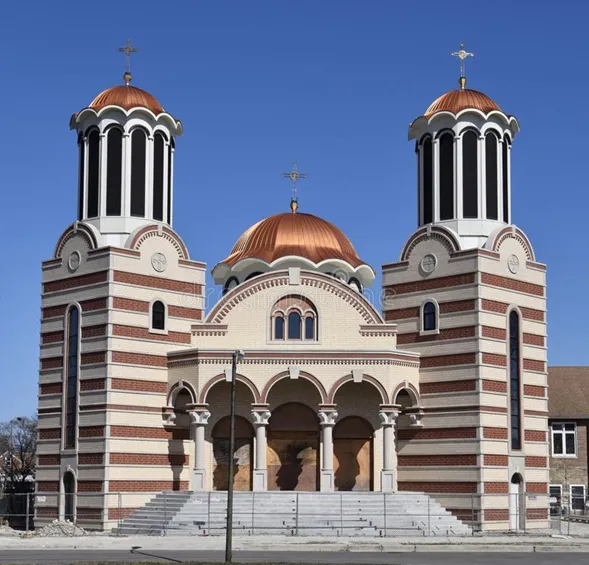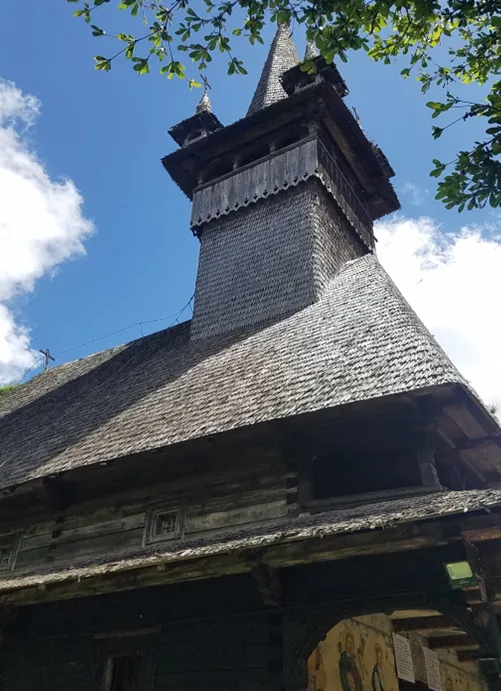
made by fitting the cut wood so that towards its end it widens in a notch made
in the same way from another wood (La iglesia fue ensamblada
con la técnica conocida como “cola de golondrina”, que se hace encajando la
madera cortada de modo que hacia su extremo se va ensanchando
en una muesca hecha de la misma forma de otro madero)
Dear reader friends of the communities that honor me with their reading, today I am going to present a Romanian Orthodox church, built in the city of Caracas practically at the beginning of this century. I made my visit to this unique temple a few moments before the mass began, which is why I was able to capture almost every corner of the church with my cell phone camera, in addition to having a very pleasant chat with the young Venezuelan priest responsible for this church, which in addition to providing its ecclesiastical services to its parishioners is an aesthetic source that adorns the place and inspires its visitors. Professor and friend Marcos Milano, in this same community, took a quick look at this church in February 2021 in a post titled "Some religious temples in Caracas."
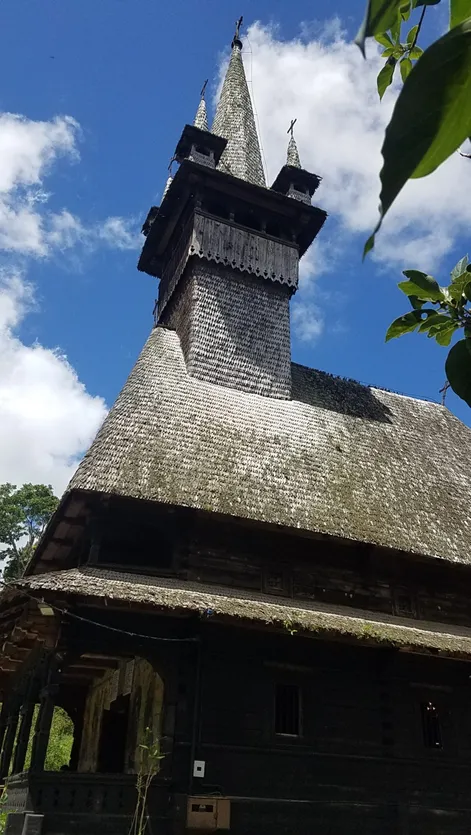
In an otherwise exquisite area of Caracas is located a small and beautiful Rumanian catholic church San Constantine and Santa Elena that is unparalleled in the country. It is a structure built entirely of wood in Transylvania, a city in the northwestern center of Romania, and brought piece by piece in a single ship to Venezuela, together with a group of 8 native Romanian artisans who would take charge of its assembly in a year and a half, as if it were a puzzle.
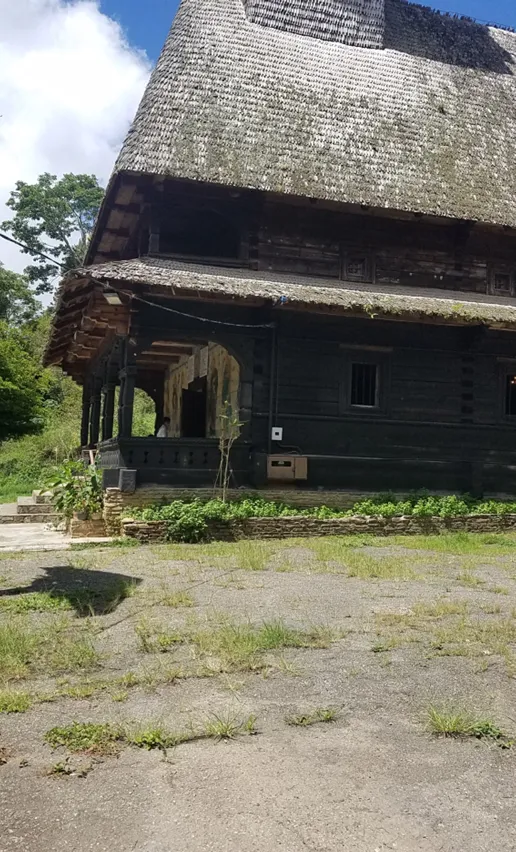
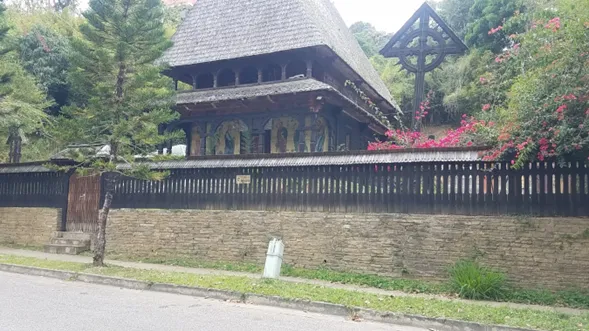
Although its original destination was the populous area of Chacao, the pieces brought from Romania ended up being assembled in 1999 in Street A, El Portón de los Olivos, the La Lagunita Urbanization, El Hatillo, Miranda state, a sparsely populated area. The church had the determined support of the more than 600 Romanian families who lived in the capital, most of them practicing Orthodox Catholics. Unfortunately, today many of them have left the country and, therefore, the number of their parishioners has significantly decreased.
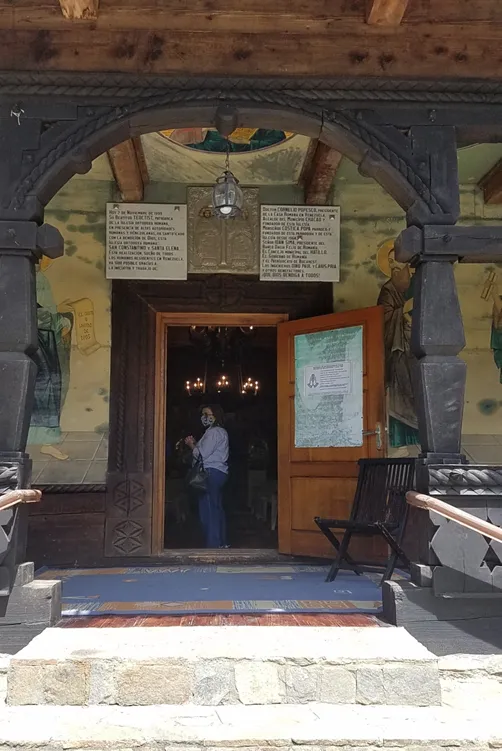
al interior de la iglesia)
The structure of the church is a replica of one of the 8 Romanian churches in the Maramures region, built during the 17th and 18th centuries, specifically, the Șurdești Wooden Church, the tallest in Romania. The set of Romanian churches has been declared a World Heritage Site by UNESCO in 1999, justifying its inclusion as "outstanding examples of popular wooden religious architecture resulting from the exchange of Orthodox religious traditions with Gothic influences (...) that show a high degree of maturity and craftsmanship artistic skills'.
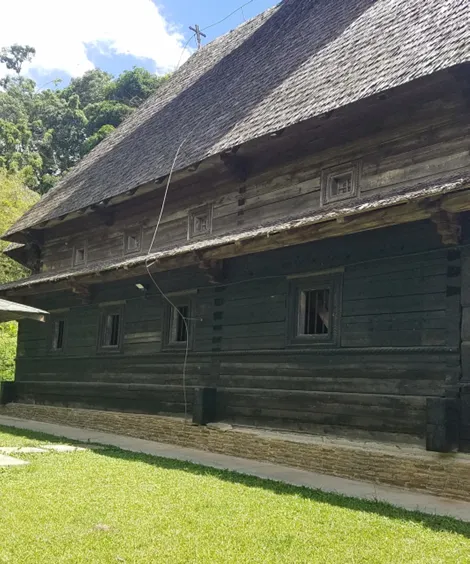
The structure was built in oak and fir wood, whose pieces fit together and interlock in such a way that they constitute a solid frame, without the need to use nails or glue for its support, respecting the tradition for the construction of Orthodox temples in Romania.


are found once you enter the church grounds (Dos cruces, una para recordar y orar
por los difuntos y la otrapara rogar por los vivos se encuentran una vez que se entra
en los predios de la iglesia)
The replica of El Hatillo is one of the two Romanian Orthodox churches built outside Europe, and was baptized as the Church of San Constantino and Santa Elena, the other is located in Chicago, Illinois, USA, although an Orthodox modern church has recently been inaugurated in that North American city, leaving the original as a kind of museum.
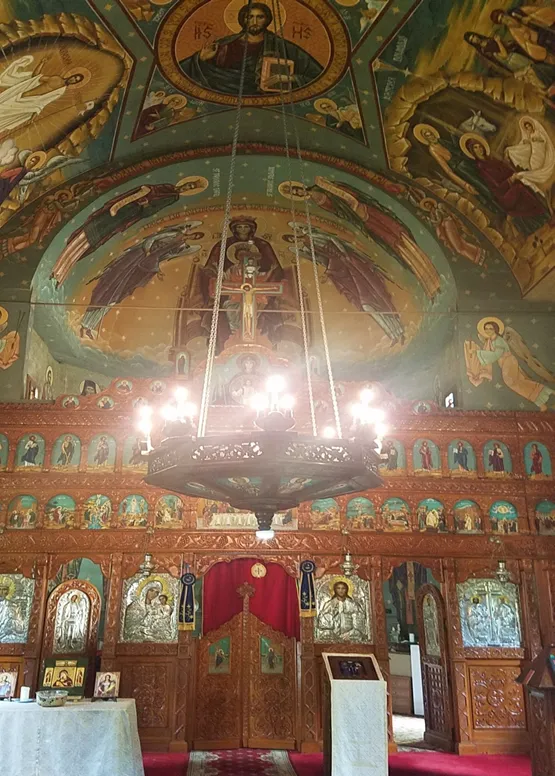
The structure of the Venezuelan church is 40 meters high, it is narrow, with a slender bell tower, in the shape of Noah's ark, located on one side, 35 meters high, which is accessed from a beautiful staircase carved in a single trunk. The roof of the temple is covered with 60 thousand wooden tiles in the shape of fish scales.
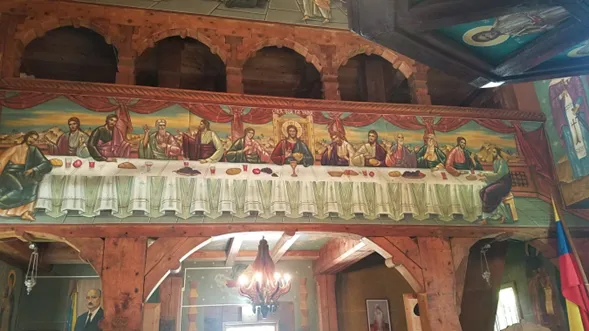
The place where the church was built is an area full of vegetation, with high humidity, which has attacked the integrity of the church by corroding its wooden structure, which is not adapted to the inclemency of the Venezuelan tropical sun, causing cracks, so the deterioration of the building has been constant. Environmental conditions have also caused some small animals, known as wood moths, or large woodworms, to damage it, so a special preparation has had to be spread on it to drive them away.
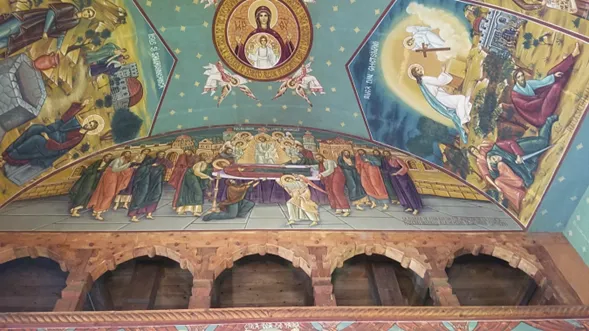
Recently, the priest in charge of the church, Antonio García, informed us, with humility and joy, that a new roof donated by the Romanian church will soon arrive in the country to replace the current one, which is extremely deteriorated. On the other hand, there are plans to build an annex in order to contribute to the training of young people in blacksmithing, carpentry and other trades.
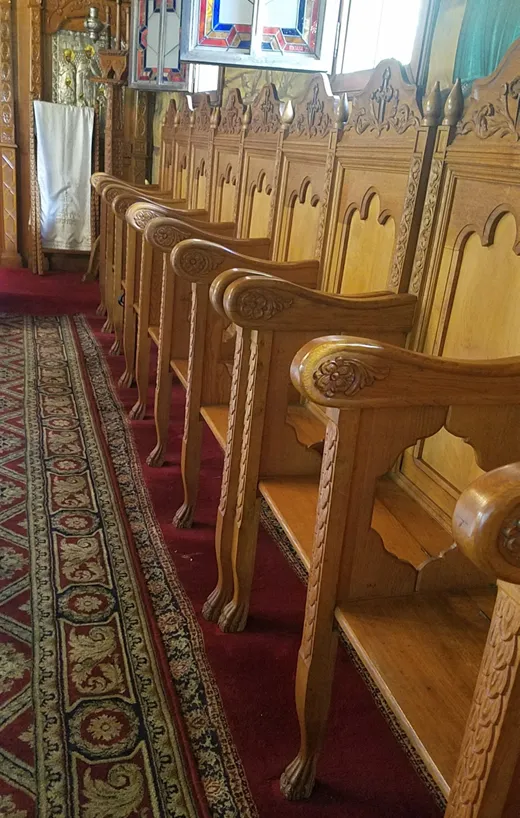
engalanan los laterales internos de la iglesia)
If the church is magnificent from the outside, once inside, its beauty is corroborated, since it can be seen that it has a small nave painted in oil with Neo-Byzantine religious images, a wall with religious paintings engraved in silver, totally upholstered, in Almost a year of arduous artistic work, with frescoes painted in situ by the Romanian artists Titiana Nitu Popa and Mihaela Profiriu, who represent the images of the apostles, the Virgin Mary and other religious figures, safeguarding the iconography of the Orthodox religion.

As a tribute to the country that has welcomed the cruch, on the left side of the pulpit is the image of the Virgin of Coromoto, patron saint of Venezuela. All that has been said makes the church be perceived as a kind of relic, a cultural sample of Romania in Latin America.
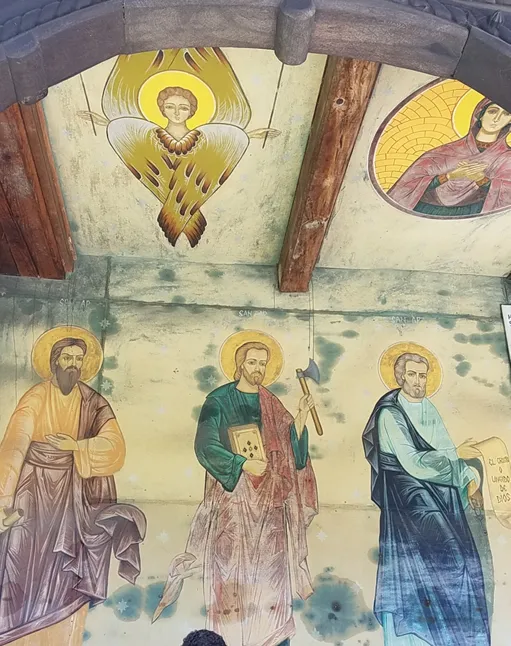
Bibliography consulted:
- Suárez, Alejandra (2016) - https://iamvenezuela.com/2016/08/iglesia-ortodoxa-rumana-san-constantino-y-santa-elena/
- Unesco. Wooden Churches of Maramureş, World Heritage List, 1999. http://whc.unesco.org/en/list/904.
- https://www.losapuntesdelviajero.com/iglesias-madera-maramures-rumania/
- https://eldiario.com/2021/05/22/iglesia-rumana-de-el-hatillo-se-deteriora-en-venezuela/

(En el jardín esta estructura sirve para hacer la merienda después de la ceremonia religiosa)
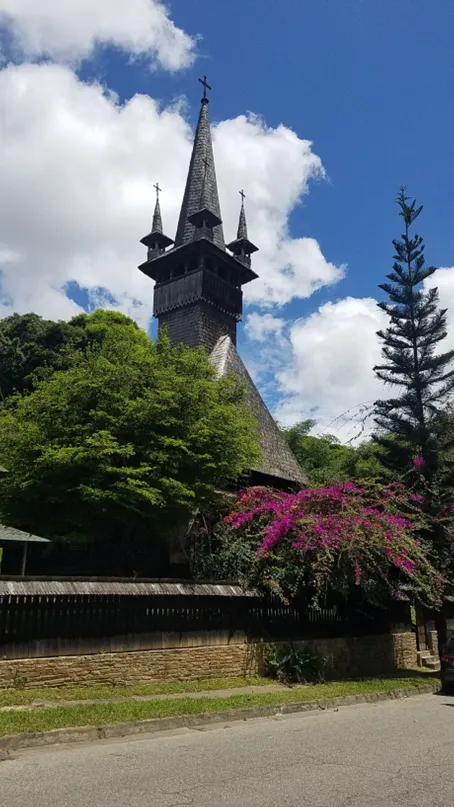
de una exuberante vegetación)
Estimados amigos lectores de las comunidades que me honran con su lectura, hoy les voy a presentar una iglesia ortodoxa rumana, construida en la ciudad de Caracas prácticamente al inicio de este siglo. Mi visita a este singular templo lo realicé pocos momentos antes de que se iniciara la misa, razón por la cual pude captar con la cámara de mi celular casi todos los rincones de la iglesia, además de mantener una charla muy amena con el joven sacerdote venezolano responsable de esta iglesia, que además de prestar sus servicios eclesiásticos a sus feligreses es una fuente estética que adorna el lugar e inspira a sus visitantes. El profesor y amigo Marcos Milano, en esta misma comunidad, pasó una mirada rasante a esta iglesia em febrero del 2021 en un post titulado “Algunos templos religiosos en Caracas”.
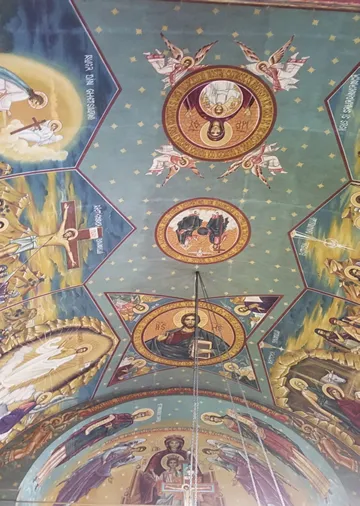
for its parishioners (Techo de la iglesia que cubre el altar y la parte
de la iglesia destinada a sus feligreses)
En una zona por lo demás exquisita de Caracas se encuentra ubicada una pequeña y hermosa iglesia católica ortodoxa rumana San Constantino y Santa Elena que no tiene parangón en el país. Se trata de una estructura construida totalmente en madera en Transilvania ciudad del centro noroeste de Rumania y traída pieza por pieza en un solo barco hasta Venezuela, conjuntamente con un grupo de 8 artesanos nativos de Rumania, quienes se encargarían en año y medio de su ensamblaje, como si fuera un rompecabezas.

with three great crosses (La iglesia consta de una planta baja, la mezzanina y
la cúpula que se corona con tres grandes cruces)
Aunque su destino original era la populosa zona de Chacao, las piezas traídas desde Rumania terminaron siendo armadas en 1999 en la Calle A, El Portón de los Olivos, Urbanización La Lagunita, El Hatillo, estado Miranda, una zona de escasa población. La iglesia contó con el apoyo decidido de las más de 600 familias rumanas que habitaban en la capital, la mayoría de ellos católicos ortodoxos practicantes. Lamentablemente, en la actualidad muchos de ellos han abandonado el país y, por lo tanto, el número de sus feligreses ha mermado significativamente.
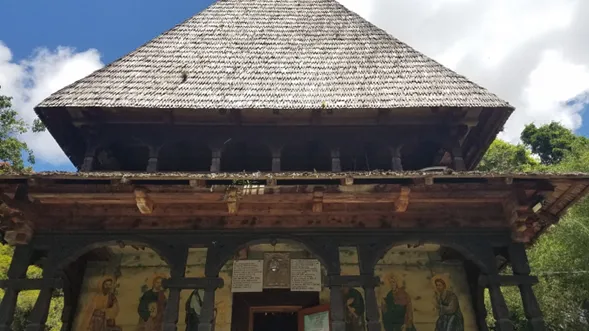
La estructura de la iglesia es una réplica de una de las 8 iglesias rumanas de la región de Maramures, construidas durante los siglos XVII y XVIII, específicamente, la Iglesia de madera de Șurdești, la más alta de Rumania. El conjunto de iglesias rumanas ha sido declarada patrimonio de la humanidad por la Unesco en 1999, justificando su incorporación patrimonial por ser «ejemplos destacados de la arquitectura religiosa popular de madera resultante del intercambio de tradiciones religiosas ortodoxas con influencias del gótico (…) que muestran un alto grado de madurez y de artesanía habilidades artísticas».

de la iglesia donde es fácil percatarse de su estructura en madera)
La estructura fue construida en madera de roble y abeto, cuyas piezas se encajan y entrelazan de manera que constituyen un armazón solido, sin que fuese necesario utilizar clavos ni pegamento para su sostén, respetando la tradición para la edificación de templos ortodoxos en Rumania.
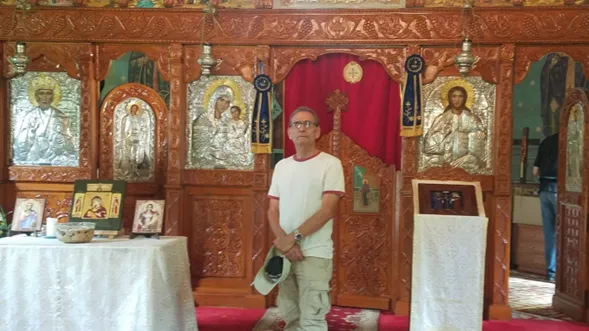
La réplica del Hatillo es una de las dos iglesias ortodoxas rumanas construidas fuera de Europa, y fue bautizada como la Iglesia de San Constantino y Santa Elena; la otra se encuentra ubicada en Chicago, Illinois, USA, aunque recientemente se ha inaugurado una iglesia ortodoxa moderna en esa ciudad norteamericana, quedando la original como una especie de museo.
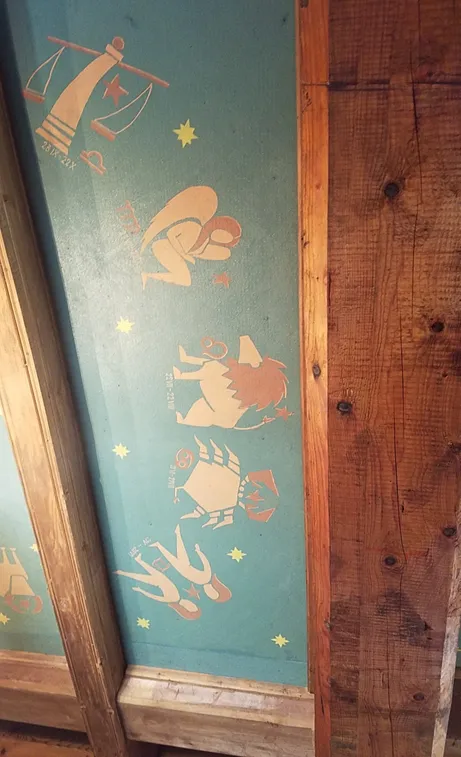
(El techo donde nos encontramos los visitantes del templo no tiene figuras religiosas)

en la zona de los visitantes)
La estructura de la iglesia venezolana tiene 40 metros de alto, es estrecha, con un esbelto campanario, en forma de arca de Noé, ubicado a un costado de la estructura, con 35 metros de altura al que se accede desde una hermosa escalera tallada en un solo tronco. El techo del templo está cubierto con 60 mil tejas de madera en forma de escamas de pescado.

El lugar donde se levantó la iglesia es una zona llena de vegetación, con una alta humedad, lo cual ha atentado contra la integridad de la iglesia al corroer su estructura de madera, que no está adaptada a la inclemencia del sol tropical de Venezuela, originando grietas, por lo que el deterioro de la edificación ha sido constante. También las condiciones ambientales han hecho que unos animalitos, conocidos como las polillas de la madera, o carcoma grande, la dañen, por lo que se le ha tenido que untar un preparado especial que las ahuyenta.
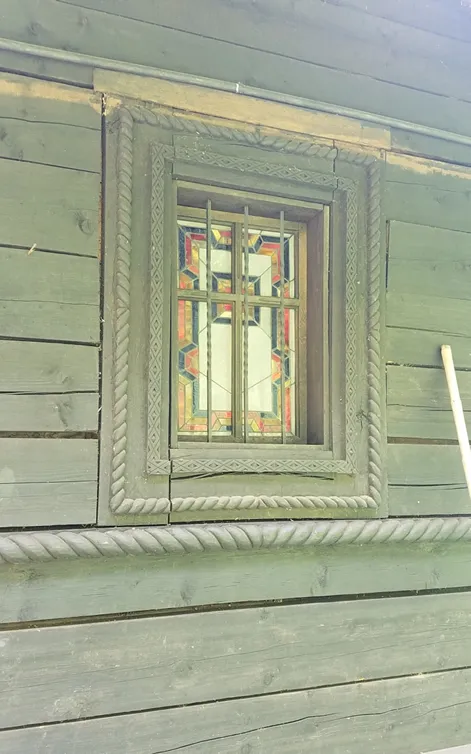
vitrales alrededor del templo)
Recientemente, el sacerdote responsable de la iglesia, Antonio García, nos informó, con humildad y alegría, que pronto llegará al país un nuevo techo donado por la iglesia rumana para reemplazar la actual que está sumamente deteriorada. Por otra parte, existen planes para construir un anexo a fin de contribuir con la formación de jóvenes en herrería, carpintería y otros oficios.
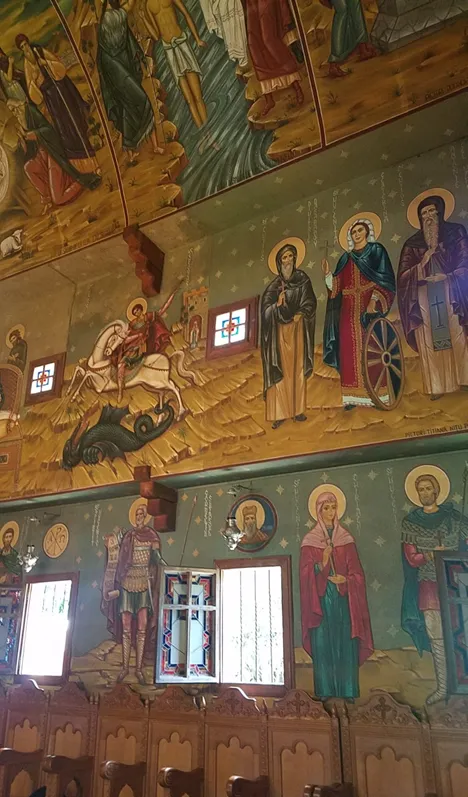
(Las figuras religiosas neobizantinas llenan plenamente la fachada principal y la
iglesia en su interior)
Si la iglesia es magnífica por fuera, una vez en su interior, se corrobora su belleza, ya que se puede apreciar que tiene una nave pequeña pintada al óleo con imágenes religiosas neobizantinas, paredes con cuadros religiosos grabados en plata, totalmente tapizada, en casi un año de arduo trabajo artístico, con frescos pintados in situ por las artistas rumanas Titiana Nitu Popa y Mihaela Profiriu, que representan las imágenes de los apóstoles, la Virgen María y otras figuras religiosas, salvaguardando la iconografía propia de la religión ortodoxa rumana.

Como homenaje al país que la ha acogido, en el lateral izquierdo del pulpito se encuentra la imagen de la Virgen de Coromoto, patrona de Venezuela. Todo lo dicho hace que la iglesia se perciba como una especie de reliquia, una muestra cultural de Rumania en Latinoamérica.
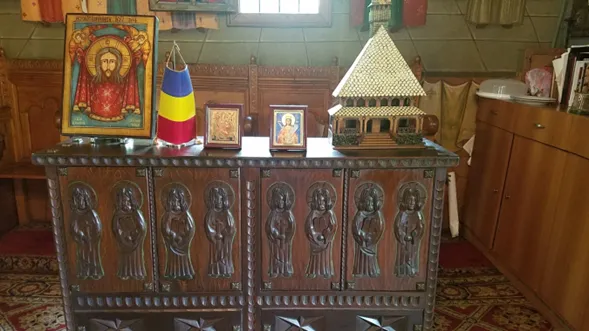
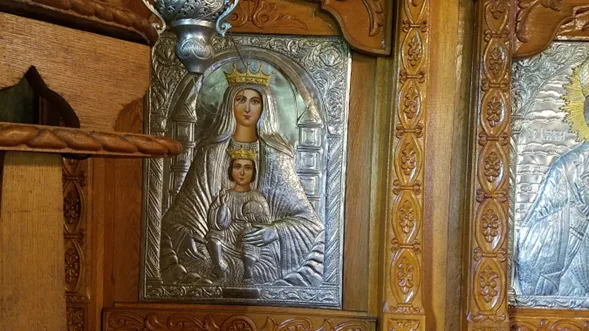
Bibliografia consultada:
- Suárez, Alejandra (2016) - https://iamvenezuela.com/2016/08/iglesia-ortodoxa-rumana-san-constantino-y-santa-elena/
- Unesco. Wooden Churches of Maramureş, World Heritage List, 1999. http://whc.unesco.org/en/list/904.
- https://www.losapuntesdelviajero.com/iglesias-madera-maramures-rumania/
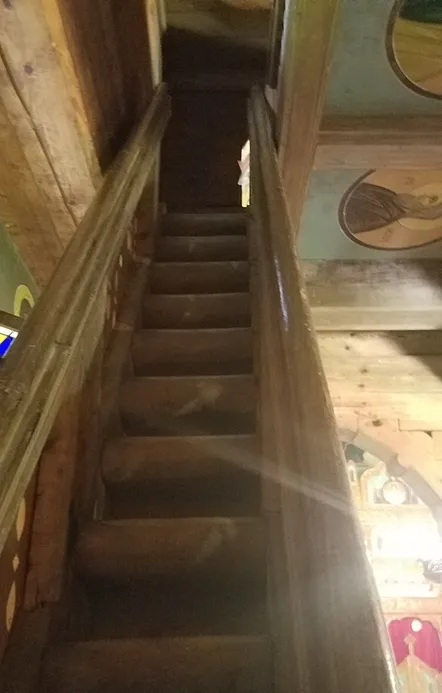
(Escalera que conduce a la mezzanina de la iglesia)
